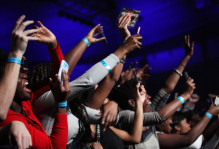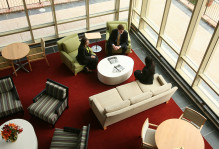Distant Discovery: Science Education Through a Screen
By Maggie Sheridan ’22
When I applied to become a Sustainability Ambassador to William & Mary’s Virginia Institute of Marine Science (VIMS) Discovery Lab program, I was still in the optimistic stage of the early pandemic. I thought (well, more like hoped) that we’d have to make it through the summer in quarantine and we’d be back to business as usual by the fall. I’d be able to make activities and posters with my project partner, Sophia Chirico, and present them to excited kids and adults in person. Obviously, that’s not what ended up happening.
I was excited for this position because I had previous experience in hands-on science education; I’d worked for the Museum of Science in Boston creating and directing activities for their Astronomy After Hours program. That experience not only made me qualified to help run the Climate Corner, it also made me passionate about it. Getting the opportunity to directly play a role in shaping people’s view of science and what it can do was formative for me and what I want to pursue in the future.
I went into this new position with this experience and excitement and soon found myself having a much more difficult time than I expected. Creating take-home activities is a far different beast than creating guided, in-lab activities. The instructions have to be clearer, the materials simpler, and the process far more guided than what I was used to. The work I had done previously stressed allowing participants to ask their own questions and find their own answers – me functioning mainly as a sounding board for their own ideas. Now that I couldn’t be there in person, I found myself having to take a more active role in providing questions and answers for people to consider in their own homes.
This is not to say that this was a bad experience; on the contrary, I found myself excited about the new challenges presented by the digital format. I got to try out graphic design on a higher level and learned so much about how to simplify information to fit within the allowed space on handouts and activities. I could no longer start talking and find my point along the way; I had to be certain of what I meant before I wrote it down. While this was challenging for me, it greatly improved my communication skills, both in-person and through writing. Having a partner to work through all of this was also a great help, and her contributions to the project elevated it far beyond what I could have done on my own.
Beyond the change in communication style, the switch to the digital format more broadly was also an exciting challenge. Creating demonstrations and activities that could be performed over Zoom was far more difficult than expected. What would have been a simple demo on watersheds when performed in a lab, became a video editing project instead. The change in format required adaptive thinking, and my partner and I spent much of the fall semester developing that skill in preparation for the labs beginning in the spring. Even a whole semester of preparation couldn’t have fully prepared us for the quick turnarounds, many revisory stages, and technical mishaps of digital Discovery Labs but I would like to think we took these in stride anyways.
The switch to online delivery created many fascinating challenges for the Discovery Lab program and for science education more broadly. While there were certainly struggles with the format, doing these labs over Zoom let us reach a far wider audience than the Labs would usually get in person. We had people from all across the country attend our digital labs and, hopefully, they all came away with a better understanding of marine science and how people can impact marine environments. This is the biggest upside of being forced online – anyone, at the click of a button, has access to engaging and educational marine science content that could deeply influence how they interact with the ocean in their everyday lives.
This extended reach makes doing digital labs, with all their challenges, incredibly worthwhile. I am so grateful to have had the opportunity to be a part of this process and to watch experienced science educators adapt so well to difficult circumstances. That being said, I do still miss in-person interactions with visitors looking to learn. There’s nothing quite like the look on someone’s face when they solve a problem they didn’t even know existed 10 minutes before. As the pandemic (hopefully!) winds down, I hope to be able to see that joy of understanding again soon.



No comments.
Comments are currently closed. Comments are closed on all posts older than one year, and for those in our archive.